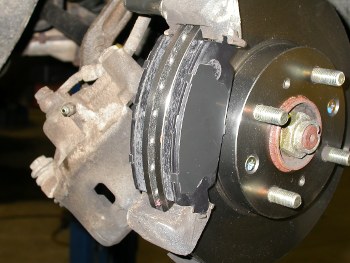 |
| February 04, 2014 | Volume 10 Issue 05 |
Designfax weekly eMagazine
Archives
Partners
Manufacturing Center
Product Spotlight
Modern Applications News
Metalworking Ideas For
Today's Job Shops
Tooling and Production
Strategies for large
metalworking plants
That's possible?! What you didn't know about silicone adhesives
By Shirley Monte, Business Development Manager, FLEXcon

Brakes: Silicone adhesives are ideal for reduction of noise and vibration.
In the world of design and engineering, solutions are not always apparent and must be sought out. Often, they are found via a combination of quick-footedness, savvy, and (everyone's favorite term) "outside-the-box" thinking, which is undoubtedly the most helpful when trying to solve a specific problem. An example of such thinking is the application of silicone adhesives to solve manufacturing challenges. Versatile and reliable, they are prime for use in the engineering of appliances, electronics, outdoor power equipment, aerospace components, and myriad other products.
Re-thinking silicone adhesives
There are many reasons silicone adhesives are considered an alternative or better solution to traditional methods for joining parts, such as screws, nuts, bolts, rivets, welds, and other mechanical fasteners. The most obvious benefits could be reduced material, labor and processing costs, ease of use, and perhaps even easier disassembly of parts, if necessary. When discussing silicone as thermally conductive, engineers assume temperature extremes are a given. Silicone can drop to -300 deg F, but at -40 deg F, acrylic begins to cross over and become crystalized and solid. Silicone adhesives, however, do not do that. Silicone adhesives possess the ability to resolve temperature differences so damping in cold environments is as possible as the more commonly thought of hot environments.
Engineers often know this, but typically think of silicone adhesives as being low tack "dry" to the touch, therefore requiring a mechanical assist throughout the manufacturing process. However, tacky silicone adhesives are available that behave similarly to acrylic adhesive, immediately forming a bond. These performance adhesives offer the initial tack of an acrylic adhesive but have the ability to withstand a broader range of temperature extremes.
"Outside the box" at work
An example of this application at work is demonstrated within electronic component manufacturing. Mechanical devices, from power tools to computer hard drives to industrial furnaces, generate noise
and vibration, which can manifest into equipment failure. Acrylic and silicone double-faced adhesive products sandwiched between substrates silence noise and eliminate vibration, while withstanding extreme heat and chemical exposure.

Adhesive rolls: Silicone adhesives are designed for extreme temperatures and offer high performance.
For instance, when assembling electronics for the retail market, silicone adhesives can be used in place of screws. When stacking components to achieve the desired level of material thickness, adhesives offer consistent level of pressure across the part, as opposed to isolated pressure points from mechanical fasteners. This is a necessary requirement, as the device could be exposed to extreme cold and the plastic materials will constrict, begin to vibrate, and cause noise. The application of silicone adhesives in place of screws adds stability, prevents misalignment, and avoids cracks in products. Moreover, they can fill gaps, join irregular-shaped surfaces, only minimally increase the weight of an assembly, and create virtually no change in part dimensions or geometry. A manufacturer can easily integrate them into an operation to achieve durability. And an added bonus? Assembly can sometimes be automated when using pressure-sensitive adhesives, which drives down production costs.
Without question, silicone adhesives can enhance product performance. When considering application-specific polymeric materials, OEMs, design engineers, and converters can benefit greatly by considering them during the earliest stages of product design. It's this kind of "outside-the-box" thinking that is essential to the long-term success of any industry -- engineering certainly included. Bringing innovative ideas to light and presenting them to customers as applicable solutions is the first step to implementing them on a macro scale. Staying focused on such goals is key, and organizations that deliver will achieve differentiation and fare better than the competition.
Want more information? Go to www.flexcon.com.
Published February 2014
Rate this article
View our terms of use and privacy policy
